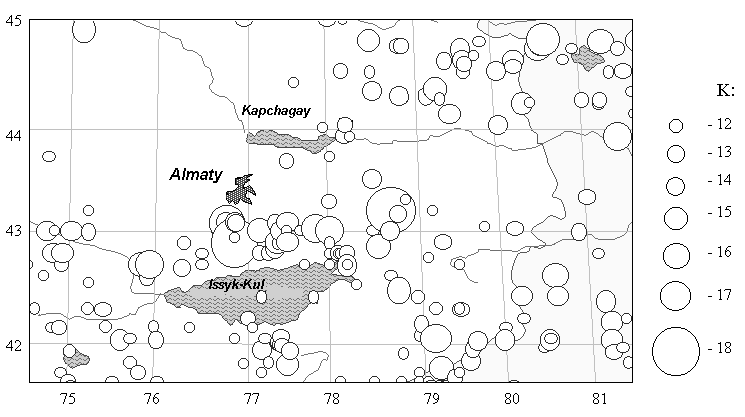
M.S.Khaidarov, V.V.Ilyina, A.Nurmagambetov, K.A.Khaidarov, P.B.Loksha
A season seismicity distribution over the North-Tian-Shan and over the Globe has been investigated. Some common regularities were found out. Sensitive sensors on the base of torsion pendulums were used for detection the microseismic background anisotropy appearing in the North-Tian-Shan. The general regularities established on the statistical level permit to make suggestion about a relation of seismicity season distribution to torsion pendulum anomalies season distribution.
The present seismic situation also can be defined as alarming one. The investigations of tendency of seismic- and geological dynamics direct to high probability of large earthquakes in this region in nearest future. It is interesting in this connection to carry out further investigation of peculiarities of seismological “life” of the region together with other geophysical fields. It should promote knowing in more details the regularities of seismic process evolution. The attempt is made of comparing the periods of anomalies in readings of torsion pendulums, which is linked by authors with anisotropy in microseism background, with increasing a seismic activity of the North Tien-Shan.
Seismic history of the North Tien-Shan is very reach with events. Since the ancient times the strong earthquakes were marked at this region, and moreover, sometimes they were destroying by results. For last 150 years there were 4 earthquakes with magnitude M ³ 7 there , two of them had the magnitude more than 8. These events were: Chilikskoe 1889 y., (M=8.3) and Keminskoe 1911y., (M= 8.2). The strong
earthquakes epicenters are presented in Fig.1 by circles with maximum radius, corresponding to K= 18 energy class.

Fig.1. The map of the epicenters of the North Tien-Shan strong earthquakes
Seismological processes at this region are connected with intensive process of tectonic activity, resulted in a lot of rupture faults and systems of large lineaments, promoting the high seismic potential of the North Tien-Shan.
The most part of residual deformations which were found in this region are not linked with any seismological events of recent years [5] and indicate to high seismic activity in the past .
In the temporal distribution of earthquakes defined ordering is presented - periods of activity and inactivity are observed in some regions. It was found for basic seismological regions, that duration of period of the more activity for the earthquakes with M ³ 6.4 is 21-25 years, and duration of the calm period – 65-75 years [7]. It seems, that period of calm for M> 7 is from 80 to 200 years [6].
It should be noticed that the largest earthquakes with M=8.3 and M=7.3 on the boundary of ages XIX-XX in the region of Almaty happened for relatively short time- 24 years. This is an exclusive phenomenon in the world practice.
Dynamic processes within the Globe give indirect reflection to different characteristics, including microseismic background. It was shown in papers [3,4] that torsion pendulums can be used for microseismic background anisotropy registration. Some examples for such anisotropy directly ahead strong earthquakes over teleseismic zone – to 10000 km were taken. Systematic investigations using torsion pendulums were not carried out.
In early 90th it was a network unfolded on the North Tien-Shan territory, provided with torsion pendulums, reacting to changes of microseismic background , namely to anisotropy appearing. Mathematical models for these devices and some results of computer simulating were described more detailed in the papers [2,4]. In spite of their simplicity, these models allowed to carry the analysis to establish some basic regularities in working the pendulum instruments, and to obtain the quantitative estimation of dependence between external influences and readings of the instruments.
Microseismic anisotropy phenomenon is investigated not sufficiently yet. In this connection it is a reasonable task – to find out on statistical level interrelation between anisotropy appearing and the future earthquakes. The authors relate appearing the peculiar anomalies in the torsion pendulums readings with a microseismic anisotropy.
Systematic investigations using the network provided with torsion pendulums, allowed making some generalizations for the area, having radius as large as 2000 km.
It was used a number of catalogues of the international and national seismological institutions: the European Mediterranean Seismological Center (EMSC), Norvegian Seismic Array (NORSAR), Data Center of IRIS Consortium, Prototype International Data Center (PIDS) sponsored by the Defence Threat Reduction Agency, National Earthquake Information Center of US Geological Survey , International Seismological Center of United Kingdom and Catalogue of strong earthquakes over the Tien-Shan with magnitude M³ 5 from ancient times till 1990, collected in collaboration of leading seismological institutions of Kazakhstan, Kirgizstan and China.
Collection and processing the initial seismological material and making the sampling were made by using a special computer program for automatic collection in Internet and following unification of data. Series of observations over 36 pendulum instruments included into the network of NPK “Prognoz”, GU “Kazselezashita” of Emergency-Agency of Republic of Kazakhstan with duration 5 years (1995-1999) were taken for analysis of microseismic anisotropy.
In devices used the pendulum assembly is hanged on the thin tungsten wire. Sensor devices are being the torsion pendulum systems arranged into massive chamber. It was shown in papers [2,4] that these sensors are in fact frequency-selecting spectrum-analyzers.
This pendulum is an indicator of vibration polarization with frequencies close to resonance frequency. In the case when sensor is subjected to vibrations of a such kind a transient process appears, after that an angle of twisting is settled distinctively different from zero. When there are few very closed frequencies near the resonance more difficult motions can be appeared and standing state will be reached never. If there is some superposition of noise with the vibrations, only some increase of dispersion can be observed.
When any anomaly linking with microseismic background anisotropy appears, the torsion pendulum reacts by twisting of wire after that the angle established keeps during few hours.
More detailed statistical data over these observations were presented in [1]. Fig.2 shows a typical graph.
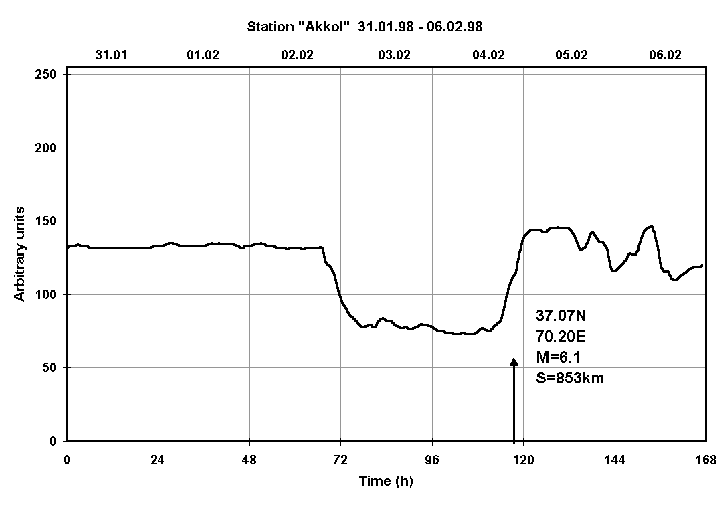
Fig.2. Characteristic view of a torsion pendulum anomaly. The axis of abscess -time interval (h), the axis of ordinates – the angle of twisting (in arbitrary units). The moment of the earthquake with a magnitude M= 6.1, distant 893 km away from Almaty, is marked by the vertical line with an arrow
The seismicity of the Earth for 2000 years relatively to destroying earthquakes including the instrumental observations for earthquakes with magnitude M ³ 6 ( more than 2000 earthquakes ) for last decades has been analyzed.
The season distribution curves obtained for different periods are given in Fig.3.
On the graphs presented some periods are distinguishly shown at which maximum of strong earthquakes occur : these are March-April, July-August, October-November. Similar month distribution were obtained for different Earth hemispheres and for large orogenic zones. The same regularity was found for the season distribution of Tien-Shan earthquakes.
For obtaining the statistical estimations over Tien-Shan and North Tien-Shan, the samplings were used, taken from the Catalogue of strong earthquakes of Tien-Shan with M> 5.0 , from the ancient till 2000 and modern data. Practically all events from 1765 to 2000 y. were included in this selection.
By taking into account that an absent of some events , which were happened in past is in most accidental , it is possible to consider the selections as accidental ones. It is confirmed by the fact that they satisfied to the Goothenberg-Richter distribution. In Fig.4 the distribution of earthquakes , included into the selections, is given.
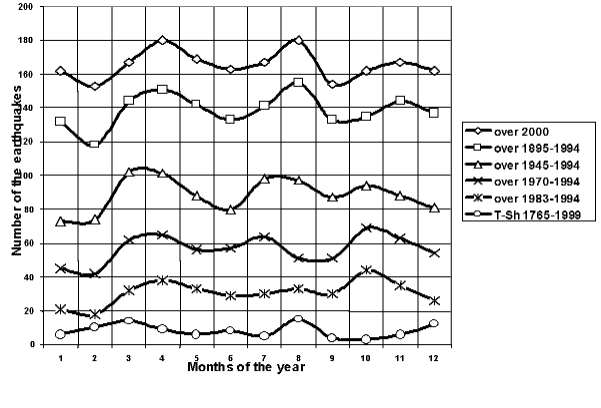
Fig.3. The season distribution of the earthquakes with M³ 6 over the Globe and over the Tien-Shan
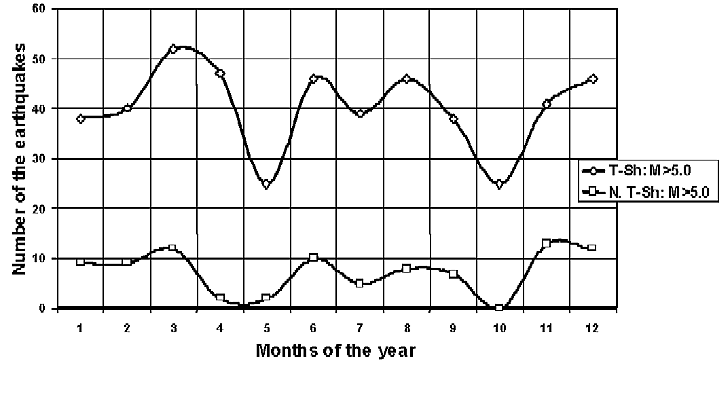
Fig.4. The season distribution of the earthquakes with M³ 5 over the Tien-Shan and the North Tien-Shan for the period of 1765-1999 y.
Fig.5 presents year- graphs of season variations for the torsion pendulums anomalies distribution. In the same figure the averaged graphs are presented over 5 years. 3-peaks view of this graph should be noticed. Periods of maximum number of anomalies set on February-March, July-August and November. It should be noticed some similarity at the season distribution of long standing seismicity and anomalies of the torsion pendulums.
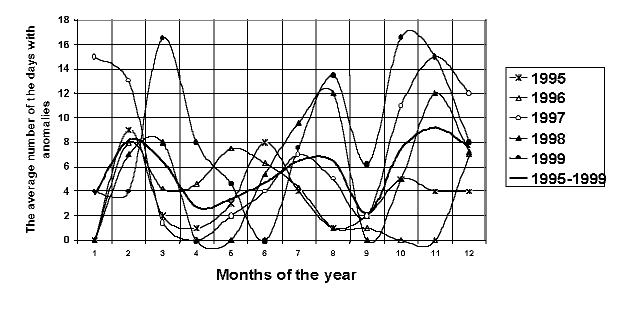
Fig.5. The season distribution of torsion pendulum anomalies for the period of 1995-1999 y.
The cross correlation functions for torsion pendulums anomalies distribution and for strong earthquakes on both TienShan and North TienShan distribution graphs are given in Fig.6. Each of them has 3-peaks -view as it was expected. Maximum correlation was found for one month shifts- it was equal 0.7. It is interesting that by this value (0.7) the graph of anomalies is ahead of the graph of earthquakes. This conclusion relates to both cross correlation graphs. For comparison, Fig.6 presents also the correlation function for the pendulum anomalies and for strong earthquakes season distribution over the world, for M ³ 6, for 1995-2000 period. One can see from the graph, that there is no essential correlation. The assumption can be made that the limit distance for noticeable changes in microseismic background is about few thousands kilometers. It is in concordance with conclusions made in the paper [4].
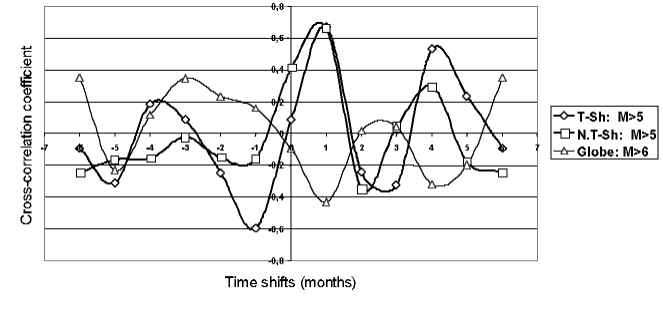
Fig.6. Cross-correlation functions of the season distributions of the torsion pendulum anomalies and strong earthquakes number
A large volume of statistical values become available at the last period thanks to inclusion of different data bases into Internet. Use of the Internet data bases allowed to find out a season distribution of seismic in global scale of the Earth as well in the local scale of the North Tien-Shan and all Tien-Shan.
The attempt of linking on statistic level the anisotropy in microseismic background appearance with the time of strong earthquakes permitted to make following preliminary conclusions. Mentioned above give not a reliable basis to consider appearing the anisotropy as direct precursor of strong earthquakes. Possibly, we deal with different phenomena of the same general process. Nevertheless, our investigations give a basis for considering the microseismic variations as one of prospective ways for strong earthquakes forecasting.
[1] Bijanov N, Khaidarov M., (1998) Seismicity and forecast of seismic danger on the territory of Kazakhstan. Thesis of XXYI General Assembly of the European Seismological Commission (ESC) International Association of Seismology and Physics of the Earth Interior (IASPEI) International Union of Geodesy and Geophysics (IUGG), TelAviv, Israel, August 23-28.
[2] Jhantaev Zh.Sh., Loksha P.B. (2000) Certain Features in the Microseismic Anisotropy Manifestations. Journal of Earthquake Prediction Research. V.8, N3. Pp.342-350.
[3] Kalinnikov I.I. (1983) Konservativnye systemy dlj geofizicheskih issledovaniy//Moskwa. Nauka. 129p.
[4] Kalinnikov I.I. (1991) Gorizontalnye krutilnye vesy - seismoprijomnik s mnogolepestkovoy diagrammoy napravlennosti. Doklady AN SSSR. Tom 317. N4. Pp.868-872.
[5] Krestnikov V.N.,BelousovT.P.et al. (1979) Chetvertichnaj tectonica Pamira i Tien-Shanj. Moskwa. Nauka.114p.
[6] SadovskiyM.A., Blhovitinov L.G., Pisarenko V.F. (1987) Deformirovanie geofizicheskoy sredy i seismicheskiy process. Moskwa. Nauka. 100p.
[7] Sydykov A., Sadykova A.B. (1997) Seismicheskiy rezhim i voprosy dolgosrochnogo prognoza. Doklady meshdunarodnogo simpoziuma 17-21 nojabrja 1997g. “Prognoz semletrjseniy i glubinnaja geodinamica”. Almaty. P.152-160
|
|